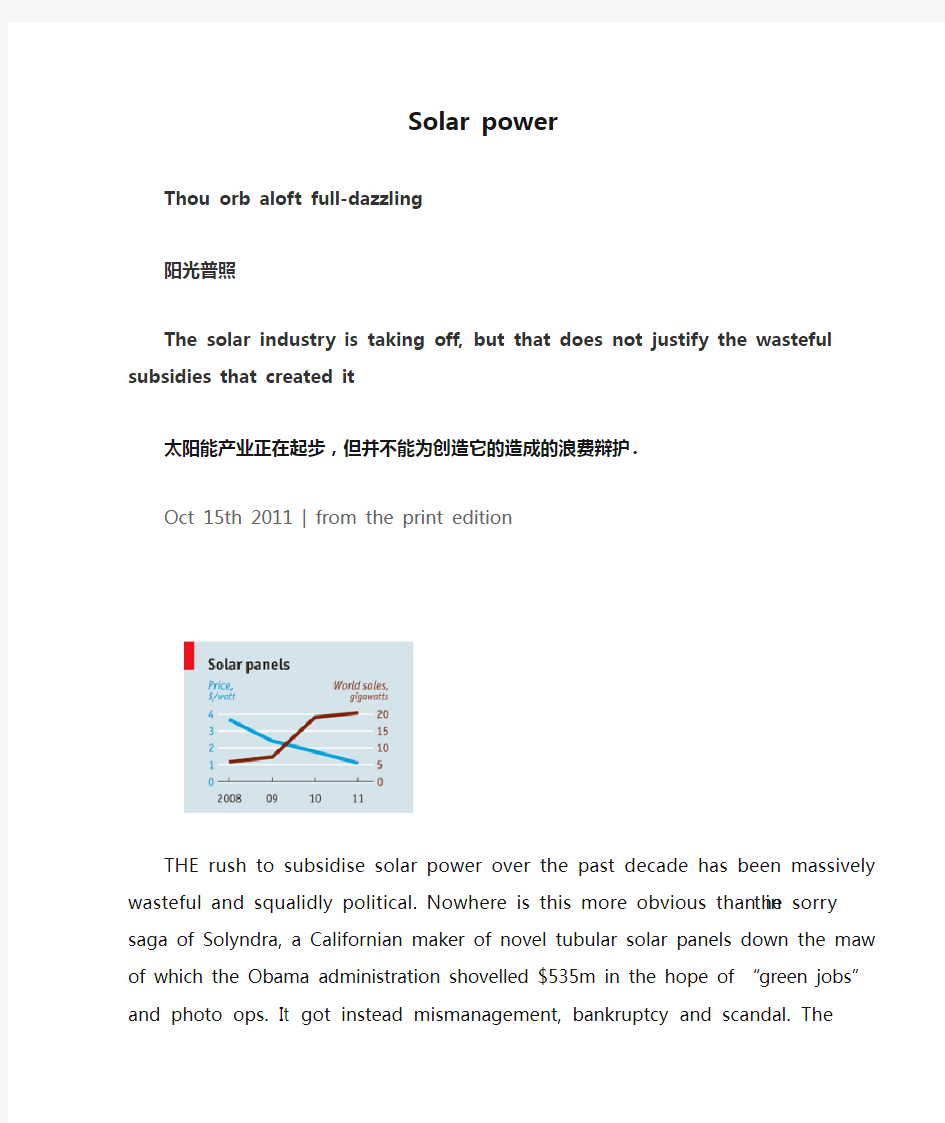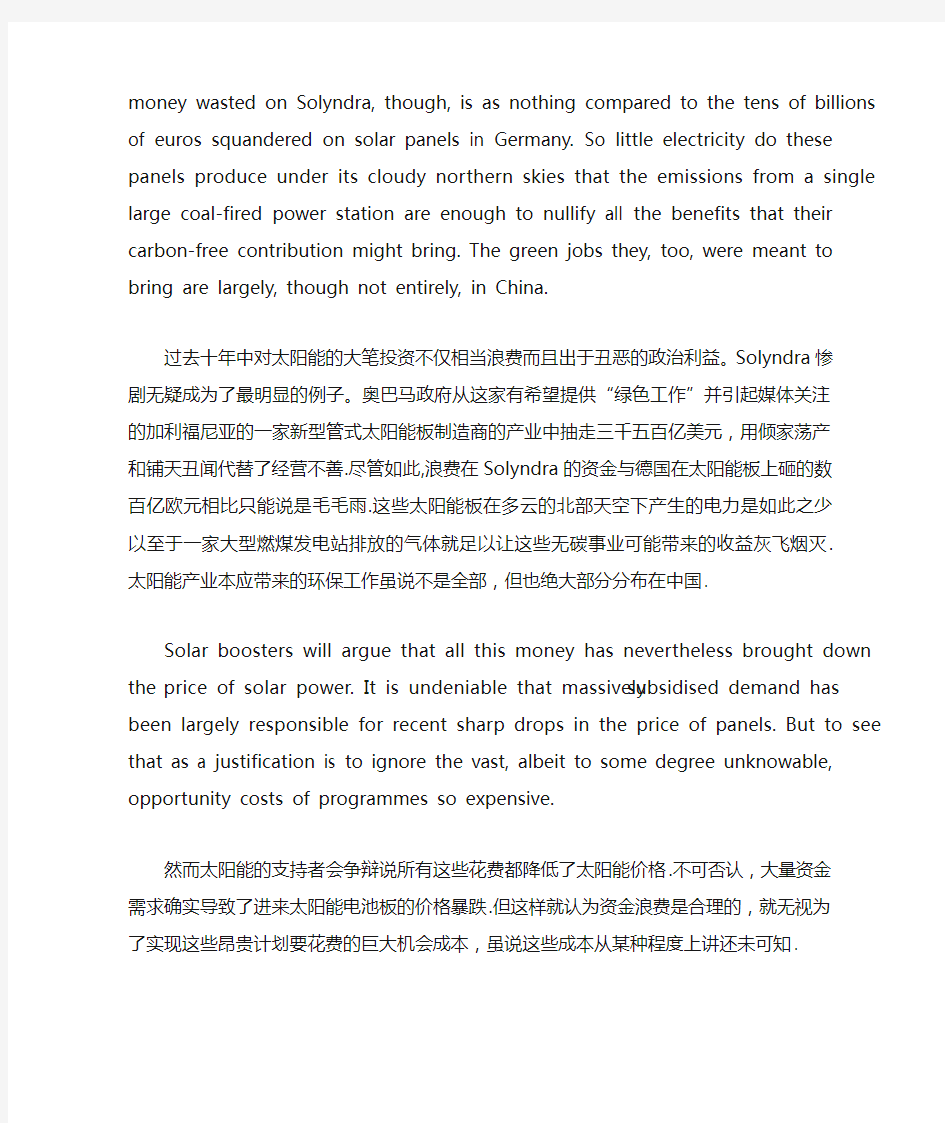Solar power


Solar power
Thou orb aloft full-dazzling
阳光普照
The solar industry is taking off, but that does not justify the wasteful subsidies that created it
太阳能产业正在起步,但并不能为创造它的造成的浪费辩护.
Oct 15th 2011 | from the print edition
THE rush to subsidise solar power over the past decade has been massively wasteful and squalidly political. Nowhere is this more obvious than in the sorry saga of Solyndra, a Californian maker of novel tubular solar panels down the maw of which the Obama administration shovelled $535m in the hope of “green jobs” and photo ops. It got instead mismanagement, bankruptcy and scandal. The money wasted on Solyndra, though, is as nothing compared to the tens of billions of euros squandered on solar panels in Germany. So little electricity do these panels produce under its cloudy northern skies that the emissions from a single large coal-fired power station are enough to nullify all the benefits that their carbon-free contribution might bring. The green jobs they, too, were meant to bring are largely, though not entirely, in China.
过去十年中对太阳能的大笔投资不仅相当浪费而且出于丑恶的政治利益。Solyndra惨剧无疑成为了最明显的例子。奥巴马政府从这家有希望提供“绿色工作”并引起媒体关注的加利福尼亚的一家新型管式太阳能板制造商的产业中抽走三千五百亿美元,用倾家荡产和铺天丑闻代替了经营不善.尽管如此,浪费在Solyndra的资金与德国在太阳能板上砸的数百亿欧元相比只能说是毛毛雨.这些太阳能板在多云的北部天空下产生的电力是如此之少以至于一家大型燃煤发电站排放的气体就足以让这些无碳事业可能带来的收益灰飞烟灭.太阳能产业本应带来
的环保工作虽说不是全部,但也绝大部分分布在中国.
Solar boosters will argue that all this money has nevertheless brought down the price of solar power. It is undeniable that massively subsidised demand has been largely responsible for recent sharp drops in the price of panels. But to see that as a justification is to ignore the vast, albeit to some degree unknowable, opportunity costs of programmes so expensive.
然而太阳能的支持者会争辩说所有这些花费都降低了太阳能价格.不可否认,大量资金需求确实导致了进来太阳能电池板的价格暴跌.但这样就认为资金浪费是合理的,就无视为了实现这些昂贵计划要花费的巨大机会成本,虽说这些成本从某种程度上讲还未可知.
Defenders of solar subsidies point out that, unlike those on biofuels, they do not actually take food from the plates of the hungry. That is true; but it is a pretty low bar. Fixating on solar power, which is still a more expensive way to generate electricity than most, has delivered little by way of emissions reductions for the subsidy buck, and left governments paying through the nose for whatever the industry can ship, rather than encouraging true innovation.
向太阳能提供补贴的支持者们指出,太阳能产业其实没有从饥民口中掠夺食物,这是不同于生物燃料的.是没错,但这个标准未免太低.太阳能发电比起其他方式仍然较为昂贵,集中投入到太阳能产业的资金并没有通过减排为政府带来任何收益,反倒要征服为它们推出的任何产品买单,这并非是在鼓励真正的创新.
Europe’s solar subsidies have proved not just expensive, but also unreliable. As so often happens with such regimes, their excessive generosity has led to a glut of output, and their cost has risen, leading governments to cut rates. Capacity will probably shrink as a result, discouraging innovation. A high price on carbon, set in such a way that investors could count on it lasting for decades, would have created a more stable business environment and thus, over the long run, brought about more innovation in clean energy.
欧洲给太阳能的补助不仅证明了这项产业十分昂贵,而且不可靠.这种状况在这样的社会体制下会经常发生,过多投入使产品供大于求,支出上升,最终导致政府减息.资本也许会因此下降,不利于创新.投资者们本指望通过这样方式设置的碳高价持续数十年,能创造出更加稳定的商业环境,并且从长远角度还能在清洁能源领域带来更多创新。
Still, by pushing the price of panels down, subsidies have created possibilities that were not there before. In some sunny parts of America, and elsewhere, people who can afford the upfront costs of solar panels on their roofs can now get electricity from them more cheaply than they can get it down the wires from a power station. Solar panels with battery back-up can now compete with diesel generators for many off-grid applications in developing countries—such as powering mobile-phone masts, which are
spreading like unsubsidised wildfire through much of the world.
尽管这样,政府补贴推动的太阳能板价格下调还是为太阳能产业提供了前所未有的发展潜力/空间/可能性.在美国和其他一些阳光充足的地区,预付了屋顶太阳能板费用的人们现在可以获得比发电站线路中更为清洁的电力.现今在发展中国家的离网应用中,带有备电的太阳能电板可以和柴油发电机竞争,例如给手机信号塔充电,而这样的信号塔正如势不可挡的野火般向世界的每个角落蔓延着.
The right way to do it 正解
There is much that governments can do to encourage such progress in the future without repeating the mistakes of the past. They should limit the grounds on which people can object to neighbours’ solar installations through the planning process. They should remove subsidies for technologies that compete with solar. In India, which has lots of sun and lots of back-up generators burning subsidised diesel, that could be a game changer in itself. Above all they must fix a price of carbon that gives innovators the confidence that competing with fossil fuels for the long term will be a rewarding, and perhaps hugely profitable, undertaking. If politics prevent them from setting a substantial carbon price, they might consider requiring utilities to have a carbon-free component to their generating portfolios, as happens in many American states. But that needs to be open to all carbon-free technologies, not just the ones that the politicians like, so that the most efficient can prosper.
在未来政府不用步之前的后尘就可以做出许多努力来鼓励这种进步.政府应该出台关于人们计划安装太阳能设施场地的相关限制条例,使得邻居的反对意见有据可循.政府应将补贴转移到能与太阳能竞争的(其他)技术领域中去.印度有充足的阳光和大量的备用柴油发电机,这可能是一个内生的转型因素.最重要的是政府必须制定碳价格,给予创新者们信心,使他们于化石燃料的长期竞争最终得到回报,并可能获得高额收益.如果政治因素使得政府没能制定一个实质的碳价格,他们也许会考虑让公用设施使用无碳的发电组件,正像美国许多州发生的一样.但这样的要求必须对所有的无碳技术通用,不能仅限于政客们喜欢的那些,这才能使效率最高的技术繁荣壮大.
In the long run, there is little reason to do ubt that a great deal of the world’s energy will come from solar systems. The sun is hugely powerful—it delivers more energy in an hour than humankind uses in a year—and unlike fossil fuels it will never run out. The application of new materials science and nanotechnology offers the possibility of cost reductions much larger than can be imagined in windpower or hydropower, in biomass or in nuclear power. But massive subsidies are not the way to build the business.
以长远眼光看,我们没有理由质疑未来世界的大多能源将由太阳能系统提供.太阳能相当强力,---它一小时提供的能量比全人类一年的用量还要多---并且不像化石燃料,它是取之不尽用之不竭的. 相比应用于风能、水力发电、生物燃料或者核能,新材料科学和纳米技术在太
阳能领域的应用将为其成本降低提供超乎想象的可能性.但是大笔补贴资金并不能把这项事业的发展引入正轨.
from the print edition | Leaders
